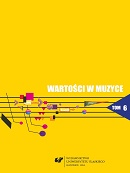Kształcenie poczucia rytmu w programach współczesnych systemów wychowania muzycznego
Teaching a Sense of Rhythm in the Programs of Contemporary Music Education Systems
Author(s): Anna WalugaSubject(s): Music
Published by: Wydawnictwo Uniwersytetu Śląskiego
Keywords: rhythm; teaching methods; music education; musical development; valuable music
Summary/Abstract: Getting to know the objectives and educational contents of the contemporary music education systems, it is easy to notice that they focus mainly on training one’s ear for music, and more rarely on developing a sense of rhythm. It results from the common conviction that one of the more difficult aspects in music education is mastering the ability to sing in tune, read and write notes. How can one, however, speak of arrhythmical singing or playing an instrument? How can one listen to music without being able to distinguish rhythm in it? Another phenomenon that has been observed (unfortunatelly, a very disturbing one) is teachers’ approach to teaching the sense of rhythm by means of explanation (often with the use of “mathematical formulae”). One cannot learn music — including rhythm — by means of learning the explanation to “how much of certain property is inherent in a certain musical item”, for even the children’s best answers to that question usually do not go together with rhythmic performance. It provoked the author of the article to consider the process of teaching a sense of rhythm, which has been developed by the contemporary authors of music education systems. It turns out that to these authors — distinguished musicians and educators — the development of children’s rhythmic skills and, consequently, their capacity for a rhythmic performance, has underlay assumptions, objectives and program contents of the above-mentioned systems. Learning them allows one to see that the ways of reaching these aims are diverse, as is the music which constitutes the basis of the educational program. Thus it is important to always reach for the most valuable music in music education, as teaching a sense of rhythm cannot be separate from the contact with themes derived from the music literature of such masters as: Bach or Bartók... not to mention folk music.
Journal: Wartości w muzyce
- Issue Year: 2014
- Issue No: 6
- Page Range: 248-269
- Page Count: 22
- Language: Polish

